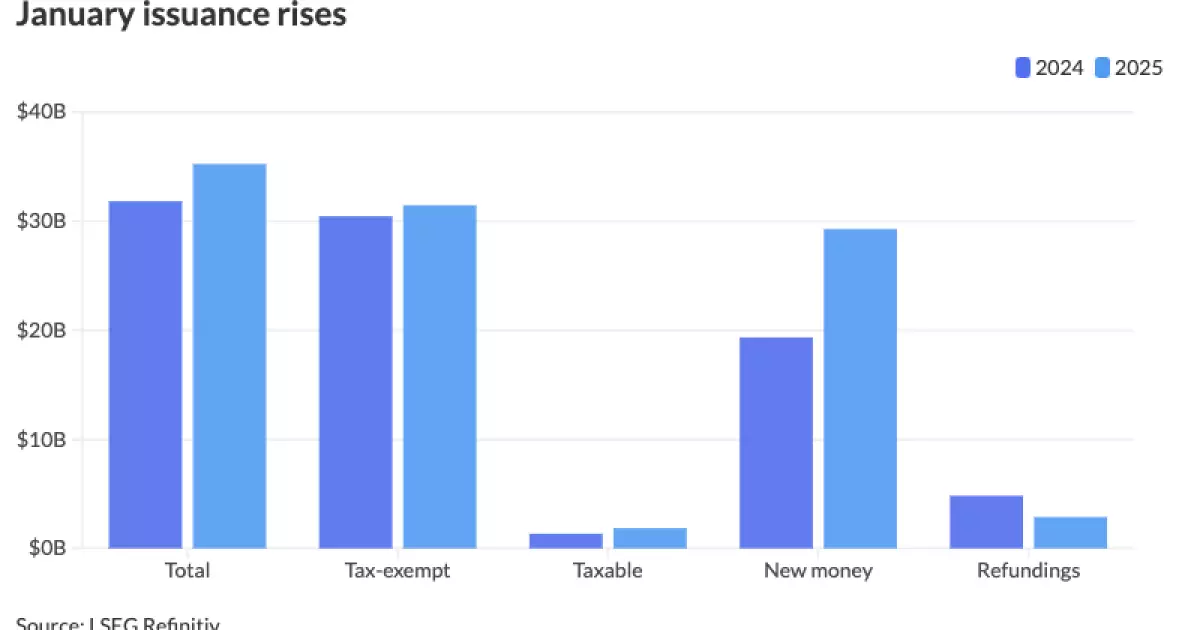The beginning of 2025 has demonstrated a notable increase in municipal bond issuance, with January reporting an unprecedented total of $35.243 billion spread across 486 issues. This marks a substantial rise of 10.8% from the previous year’s figure of $31.817 billion in 554 issues. These figures not only reflect a year-on-year increase but also exceed the ten-year average for January, which stands at $28.675 billion. Market participants attribute this uptick to a combination of policy uncertainty, potential tax changes, and a proactive approach from issuers.
One of the main drivers behind this surge is the urgency to navigate through anticipated market volatility. Analysts, including Alice Cheng from Janney, suggested that issuers are keenly aware of the changing economic landscape driven by new administrative policies related to fiscal and monetary affairs. The Federal Open Market Committee’s recent decision to maintain interest rates between 4.25% and 4.50% has added a layer of complexity to the market. The pressure from political realms, particularly from President Donald Trump for a rate cut, combines with ongoing uncertainty surrounding these policy decisions.
There is also a palpable concern among issuers regarding the potential changes to the Infrastructure Investment and Jobs Act. Cheng indicated that fears surrounding possible retraction of available funds have prompted many to seek market access sooner rather than later, despite the generally unfavorable interest rate environment during January. The urgency of addressing capital needs reflects a strategic approach by municipalities ahead of anticipated fiscal shifts.
Tax exemptions are playing a pivotal role in shaping the issuance landscape. Comments from James Pruskowski, Chief Investment Officer at 16Rock Asset Management, emphasized the looming concerns regarding targeted tax changes, especially related to healthcare and private educational institutions. This has led to an acceleration of deals being front-loaded into the early part of the year—a trend that aligns with January’s vigorous issuance activity.
Despite the traditionally slow start of a new calendar year, various market indicators suggest this could be a telling year for municipal bonds. Not only are rates currently high, but inflows into mutual funds and ETFs remain strong, fostering an environment of pent-up demand. Rob Dailey from PNC Public Finance pointed out that following a period of minimal market activity, municipalities now face pressure to advance deferred projects, catalyzed further by federal funding for infrastructure.
Upcoming Expectations and Future Projections
As market participants analyze the recent trends, many are optimistic about the sustained momentum of municipal issuance for the remainder of 2025. By comparing January’s issuance to historical data, analysts expect a robust pipeline of future projects. Barclays strategist Mikhail Foux stated that, despite a typically slower start to the year, the visible supply for the next 30 days remains healthy and robust.
Another contributory factor lies in the dwindling resources linked to COVID-era funding. The expiration of federal aid has compelled issuers to tap the capital markets actively. January marked an opportune moment for issuers to come to market, aligning with their financial needs and project timelines. With inflation rates easing, issuers are exploring innovative funding solutions to accommodate their capital projects.
Breakdown of January’s Issuance Figures
Breaking down January’s issuance figures, tax-exempt bonds accounted for $31.45 billion, marking a 3.3% increase from the previous year. Taxable issuance experienced a notable rise of 36.7%, amounting to $1.849 billion. Key categories such as new-money issuance surged by 51.4% to reach $29.268 billion, while refunding activities saw a significant decrease of 40.4%. Notably, revenue bonds rallied by 14%, while general obligation bonds experienced a slight uptick of 4.4%.
The distribution of issuance across states outlined dynamic growth patterns: California led the way with $6.371 billion, reflecting a modest year-on-year growth, while Texas and Florida also exhibited impressive increases. In contrast, Massachusetts reported a significant decline, emphasizing the varied regional responses to market conditions.
January’s issuance wave suggests that a renewed wave of enthusiasm and strategic action in the municipal bond market is underway, preparing stakeholders for what promises to be a transformative year for municipal finance. As these dynamics unfold, the interplay of government policy, market conditions, and issuer strategies will be crucial in shaping the landscape for the foreseeable future.

